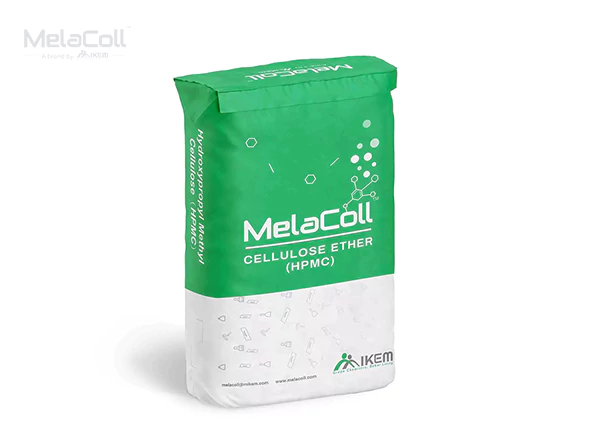
현대식 건물 장식에서 벽 퍼티는 벽을 준비하는 기본 재료이며, 그 품질은 마감재의 전체적인 외관과 내구성에 직접적인 영향을 미칩니다. 벽 퍼티의 도포 성능과 최종 품질을 향상시키기 위해 히드록시프로필메틸셀룰로오스(HPMC)가 일반적으로 사용되는 첨가제가 되었습니다. 하지만 HPMC 퍼티의 성능과 효과에 중요한 몇 가지 핵심 요소가 포함되어 있습니다. 건축업자와 자재 개발자는 다음 5가지 핵심 질문을 이해하는 것이 중요합니다. 이러한 질문에 대한 답은 퍼티의 배합과 적용을 최적화하여 벽 마감재의 품질과 수명을 보장하고 궁극적으로 더 나은 시공 경험과 결과를 이끌어내는 데 도움이 됩니다. 이러한 질문에 대해 얼마나 잘 알고 있는지 알아봅시다.
1. 벽면 퍼티에서 HPMC의 역할은 무엇인가요?

멜라콜® HPMC는 퍼티의 수분 보유력을 획기적으로 향상시킬 수 있습니다.
답변: HPMC는 다음 분야에서 중요한 역할을 합니다. 벽 퍼티. 첫째, 퍼티의 수분 보유력을 크게 향상시키고 건조 과정에서 수분이 쉽게 손실되지 않도록하여 퍼티의 조기 건조 또는 초킹을 방지합니다. 둘째, HPMC는 퍼티의 점도를 조절하여 작업하기 쉽게 만들고 퍼티의 요변성을 개선하여 도포 시 부드러움과 균일성을 보장하는 점증 효과가 있습니다. 또한 HPMC는 퍼티의 작업성을 개선하여 긁어내기가 더 부드러워지고 작업 가능 시간이 길어지며 매끄럽고 균일한 벽면을 형성하는 데 도움이 됩니다. 또한 퍼티의 기질에 대한 접착력을 향상시켜 퍼티 층이 벽면에 단단히 밀착되도록 하여 박리 및 캐비테이션의 위험을 줄입니다. 마지막으로 HPMC는 특히 수직 벽에 작업할 때 퍼티의 처짐 방지 특성을 개선하여 퍼티의 처짐을 효과적으로 방지하고 균일한 코팅 두께를 보장합니다. 이러한 복합적인 효과로 인해 HPMC는 벽 퍼티에 없어서는 안 될 중요한 첨가제로서 벽 장식의 품질과 내구성을 크게 향상시킵니다.
2. HPMC 첨가량이 퍼티의 성능에 미치는 영향은 무엇인가요?
답변: HPMC의 첨가량은 퍼티의 성능에 큰 영향을 미칩니다. 적절한 양의 HPMC를 첨가하면 퍼티의 수분 유지력, 농축성, 접착력을 최적화하고 시공의 부드러움과 퍼티의 처짐 방지 특성을 개선할 수 있습니다. 그러나 HPMC를 너무 적게 첨가하면 이러한 장점이 충분히 발휘되지 않아 퍼티가 너무 빨리 마르거나 접착력이 부족하거나 작업성이 저하될 수 있고, 너무 많이 첨가하면 퍼티의 점도가 너무 높아져 시공 시 퍼짐이 어렵고 경화 속도와 표면 평활도에 영향을 미칠 수 있습니다. 따라서 HPMC 첨가량을 정밀하게 제어하는 것이 퍼티가 최상의 성능을 발휘하고 시공 품질과 벽면 효과를 향상시키는 핵심입니다.
3. HPMC의 성능은 어떻게 다른가요?기후 조건?

HPMC의 우수한 수분 보유력은 퍼티의 수분 증발 속도를 효과적으로 늦춰 조기에 마르거나 갈라지는 것을 방지하여 벽 표면의 품질을 보장합니다.
답변: HPMC는 다양한 기후 조건에서 안정적이고 신뢰할 수 있는 성능을 보여줍니다. 건조한 기후에서는 HPMC의 우수한 수분 보유력이 퍼티의 수분 증발을 효과적으로 늦춰 조기에 마르거나 갈라지는 것을 방지하여 벽 표면의 품질을 보장합니다. 습한 기후에서는 HPMC의 내습성이 퍼티의 수분 흡수를 제어하여 벽 표면의 물집, 변형 또는 벗겨짐을 방지하는 데 도움이 됩니다. 고온 조건에서 HPMC의 열 안정성은 시공 중 퍼티가 적절한 시간 동안 작동하도록 유지하여 너무 빨리 경화되는 것을 방지합니다. 저온 환경에서도 HPMC는 퍼티의 유동성과 작업성을 유지하여 저온으로 인해 퍼티가 너무 두꺼워지거나 도포하기 어려워지는 것을 방지할 수 있습니다. 따라서 HPMC는 변화하는 기후 조건에서 퍼티의 안정성과 작업성을 보장하고 다양한 지역과 계절의 벽 장식 요구 사항에 적응할 수 있습니다.
4. HPMC는 석고나 라텍스 파우더와 같은 다른 퍼티 첨가제와 어떻게 상호작용하나요?
답변: HPMC는 석고 및 라텍스 파우더와 같은 다른 퍼티 첨가제와 시너지 효과를 발휘하여 퍼티의 전반적인 성능을 최적화합니다. 석고와 함께 사용하면 HPMC의 수분 유지 및 농축 작용으로 석고 퍼티의 작업성이 향상되고 작업 시간이 연장되며 건조 및 균열을 방지하고 퍼티 접착력과 표면 평탄도가 향상됩니다. 라텍스 파우더는 우수한 접착력과 균열 방지 특성을 제공하며 HPMC의 농축 및 수분 유지 기능을 보완하여 더욱 탄력 있고 내구성 있는 퍼티 층을 형성합니다. 또한 HPMC는 퍼티의 점도와 요변성을 효과적으로 조절하여 라텍스 파우더와 혼합된 퍼티가 더 쉽게 도포되고 더 나은 레벨링 특성을 갖도록 할 수 있습니다. 합리적인 비율을 통해 HPMC, 석고 및 라텍스 분말은 서로를 향상시키고 퍼티의 균열 방지, 내수성 및 시공 성능을 향상시켜 벽 표면이 매끄럽고 아름답고 내구성이 뛰어나도록 보장 할 수 있습니다.
5. 퍼티에서 HPMC의 최적 점도는 얼마인가요?
답변: 적절한 점도 의 퍼티 내 HPMC 함량은 일반적으로 퍼티의 특정 배합, 적용 환경 및 시공 요구 사항에 따라 달라집니다. 일반적으로 벽면 퍼티에 적합한 HPMC 점도는 40,000~100,000mPa.s 범위입니다(2% 수용액의 점도 측정 기준).
점도 선택의 영향
저점도 HPMC(40,000~60,000mPa.s): 빠른 도포와 확산을 위해 더 높은 흐름과 낮은 농도가 필요한 퍼티용입니다. 이 점도는 더 빨리 건조되고 넓은 영역에서 작업하기 쉽기 때문에 얇은 코팅이나 따뜻한 환경에서 사용하기에 적합합니다.
중간 점도 HPMC(60,000-80,000 mPa.s): 흐름과 수분 유지의 균형을 맞추며 대부분의 범용 외장 퍼티 용도에 적합합니다. 이 점도는 작업성이 우수하고 건조 중에 퍼티가 갈라지거나 벗겨지는 것을 방지합니다.
고점도 HPMC(80,000-100,000 mPa.s): 더 높은 수분 유지력과 더 긴 개봉 시간이 필요한 퍼티의 경우 덥고 건조한 환경이나 더 두꺼운 코팅이 필요한 곳에 사용하기에 적합합니다. 이 점도는 퍼티가 오랜 작업 시간 동안 적절한 수분과 접착력을 유지하도록 돕고 퍼티가 조기에 건조되는 것을 방지합니다.

멜라콜®HPMC 점도
올바른 점도를 결정하는 방법
테스트 및 조정: 특정 적용 요구 사항에 따라 소량 배치 시험을 통해 다양한 점도의 HPMC를 테스트하고 퍼티의 수분 보유력, 유동성, 작업성 및 최종 건조 효과를 관찰하여 가장 적합한 점도 범위를 결정하는 것이 좋습니다.
건설 환경
또한 건축물의 주변 온도와 습도도 고려해야 합니다. 덥고 건조한 환경이라면 고점도 HPMC를 선택하는 것이 더 적합할 수 있고, 춥고 습한 환경이라면 저점도 또는 중간 점도의 HPMC를 선택하는 것이 가능할 수 있습니다.
결론
퍼티의 주요 첨가제로서 HPMC를 적용하는 데에는 몇 가지 중요한 문제가 수반됩니다. 퍼티에서 HPMC의 역할, 첨가량의 효과, 다양한 기후 조건에서의 성능, 다른 첨가제와의 상호 작용, 최적의 점도 선택을 탐구함으로써 퍼티의 배합 및 적용을 최적화하는 방법에 대한 심층적인 이해를 얻을 수 있습니다. 이는 벽 마감재의 품질과 내구성을 개선하는 데 도움이 될 뿐만 아니라 건축 프로젝트의 시공 경험과 결과를 개선하는 데도 도움이 됩니다. 결론적으로, HPMC 사용에 대한 정확한 이해는 모든 조건에서 원하는 벽 마감 결과를 얻을 수 있도록 보장합니다. 벽면 퍼티에 HPMC에 대한 질문이나 비즈니스 요구 사항이 있으시면 다음 연락처로 문의해 주세요. 문의하기 를 클릭하세요.


댓글 남기기